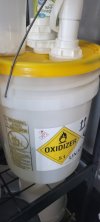- Joined
- Oct 19, 2017
- Messages
- 1,817
- Reaction score
- 2,379
- Points
- 113
Listening to this podcast - https://beersmith.com/content/controlling-oxygen-in-beer-with-colin-kaminski-beersmith-podcast-293/.
It surprised me to hear that in their canning experiments they found that sanitiser was one of the bigger contributors to dissolved oxygen in the cans. Not the active ingredients in the sanitiser so much, as the tap water that makes up 90 odd percent of the sanitiser. So much that they didn't sanitise the cans. Just purged the cans with CO2. On the few commercial canning lines I've seen I've been surprised there's no sanitiser used, just a UV light and CO2 purge.
He then started to speculate on how he'd change his process if it was homebrew into a keg. He said he'd no longer fill the keg with sanitiser and push the sanitiser out with CO2. Instead he'd just wash, dry, then fill. Once full he'd then purge the headspace a few times. He didn't have any trials of that, he was just speculating based on his canning trials. Though keg conditioning Could be another way to remove the O2. He didn't mention either of the metabisufites, though you'd imagine they'd have a similar effect to keg conditioning.
So I'm no longer sure that the purging the keg is that worth it compared to just purging the head space after filling. Though this approach does open up a slightly larger risk of spoilage from some microbe that can survive in finished beer (of which there are very few).
Any thoughts on the pointlessness of existence? Or at least the purging of kegs using liquids with high amounts of dissolved oxygen?
It surprised me to hear that in their canning experiments they found that sanitiser was one of the bigger contributors to dissolved oxygen in the cans. Not the active ingredients in the sanitiser so much, as the tap water that makes up 90 odd percent of the sanitiser. So much that they didn't sanitise the cans. Just purged the cans with CO2. On the few commercial canning lines I've seen I've been surprised there's no sanitiser used, just a UV light and CO2 purge.
He then started to speculate on how he'd change his process if it was homebrew into a keg. He said he'd no longer fill the keg with sanitiser and push the sanitiser out with CO2. Instead he'd just wash, dry, then fill. Once full he'd then purge the headspace a few times. He didn't have any trials of that, he was just speculating based on his canning trials. Though keg conditioning Could be another way to remove the O2. He didn't mention either of the metabisufites, though you'd imagine they'd have a similar effect to keg conditioning.
So I'm no longer sure that the purging the keg is that worth it compared to just purging the head space after filling. Though this approach does open up a slightly larger risk of spoilage from some microbe that can survive in finished beer (of which there are very few).
Any thoughts on the pointlessness of existence? Or at least the purging of kegs using liquids with high amounts of dissolved oxygen?











